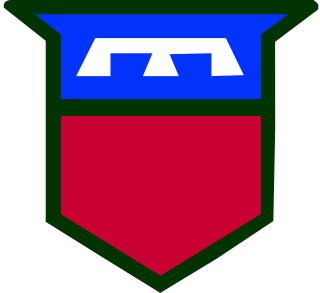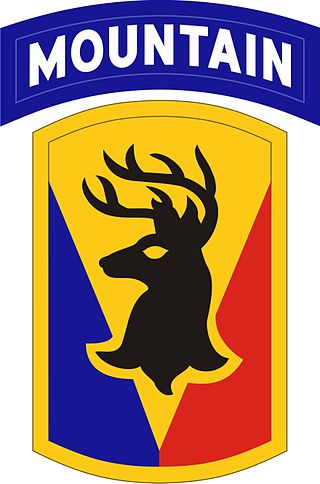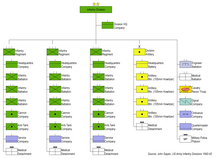
The 36th Infantry Division ("Arrowhead") also known as the "Panther Division", the "Lone Star Division", "The Texas Army", and the "T-patchers", is an infantry division of the U.S. Army and part of the Texas Army National Guard. The 36th Infantry Division was organized during World War I (1914–1918) from units of the Texas National Guard and of the Oklahoma National Guard. As an all-Texas unit, the Arrowhead Division was called to service for World War II (1937–1945) on 25 November 1940, was deployed to the European Theater of Operations in April 1943, and returned to the Texas Army National Guard in December 1945.

The 91st Infantry Division (famously nicknamed as the "Wild West Division" with a "Fir Tree" as its Division insignia to symbolize its traditional home of the Far West) is an infantry division of the United States Army that fought in World War I and World War II. From 1946 until 2008, it was part of the United States Army Reserve. It was briefly inactivated from 2008 until 2010 when it was elevated back to a division size element as the 91st Training Division (Operations).

The 35th Infantry Division, formerly known as the 35th Division, is an infantry formation of the United States Army National Guard headquartered at Fort Leavenworth, Kansas.

The 76th Infantry Division was a unit of the United States Army in World War I, World War II and the Cold War. The division was inactivated in 1996 and has been reconstituted as the 76th US Army Reserve Operational Response Command in 2013.

The 44th Infantry Division was a division of the United States Army National Guard from October 1920 to November 1945, when it was inactivated after Federal Service during World War II. A second 44th Infantry Division existed in the Illinois Army National Guard from 1946 until October 1954, when that division was disbanded after federal service during the Korean War.

The 6th Infantry Division was an infantry division of the United States Army active in World War I, World War II, and the last years of the Cold War. Known as "Red Star", it was previously called the "Sight Seein' Sixth".

The 37th Infantry Division was a unit of the United States Army in World War I and World War II. It was a National Guard division from Ohio, nicknamed the "Buckeye Division". Today, its lineage is continued through the 37th Infantry Brigade Combat Team, with battalions from Ohio, Michigan, and South Carolina.

The 33rd Infantry Division was a formation of the U.S. Army National Guard between 1917 and 1968. Originally formed for service during World War I, the division fought along the Western Front during the Battle of Amiens, the Battle of Hamel, the Meuse-Argonne Offensive, at the Second Battle of the Somme, and at the Battle of Saint-Mihiel. It was re-formed during the inter-war period, and then later activated for service during World War II, seeing action against the Imperial Japanese Army in the Pacific. In the post war era, the division was reconstituted as an all-Illinois National Guard division. In the late 1960s, the division was reduced to a brigade-sized formation, and its lineage is currently perpetuated by the 33rd Infantry Brigade Combat Team.

The 27th Infantry Division was a unit of the Army National Guard in World War I and World War II. The division traces its history from the New York Division, formed originally in 1908. The 6th Division designation was changed to the 27th Division in July 1917.

The 85th Infantry Division also known as "Custer Division" was an infantry division of the United States Army in World War I and World War II. It currently exists as the 85th Support Command.

The 86th Infantry Brigade Combat Team (Mountain) ("The Vermont Brigade") is an Army National Guard light infantry brigade headquartered in Vermont. It was reorganized from an armored brigade into an Infantry Brigade Combat Team (IBCT) as part of the United States Army's transformation for the 21st century. The 86th IBCT utilizes the Army Mountain Warfare School, co-located at Ethan Allen Firing Range in Jericho, Vermont, to train in individual military mountaineering skills so the entire brigade can be skilled in such warfare. This large conventional unit level mountain warfare capability had been lost when the 10th Mountain Division deactivated after World War II. This left the 86th IBCT as the only mountain warfare unit in the U.S. military whose soldiers were trained in mountain warfare, with individual soldiers being graduates of Ranger School, the Special Forces Advanced Mountain Operations School, and the Army Mountain Warfare School instead of entire units that specialized in such tactics. "The Vermont Brigade" configured itself to be such a unit.

The 26th Infantry Division was an infantry division of the United States Army. A major formation of the Massachusetts Army National Guard, it was based in Boston, Massachusetts for most of its history. Today, the division's heritage is carried on by the 26th Maneuver Enhancement Brigade.

The Rhode Island Army National Guard (RIARNG) is the land force militia for the U.S. state of Rhode Island. It operates under Title 10 and Title 32 of the United States Code and operates under the command of the state governor while not in federal service. National Guard units may function under arms in a state status, therefore they may be called up for active duty by the governor to help respond to domestic emergencies and disasters, such as those caused by hurricanes, floods, or civil unrest.

The 43rd Air Defense Artillery Regiment is an air defense artillery regiment of the United States Army first constituted 1918 in the Regular Army.

The 126th Aviation Regiment is a unit of the U.S. Army National Guard.

The 103rd Field Artillery Regiment is a regiment of the United States Army. The only currently existing component is the 1st Battalion, 103rd Field Artillery Regiment, a unit of the Rhode Island National Guard. The regiment was originally constituted in 1917, but it descends from predecessor units dating back to 1801.

The 102nd Infantry Regiment currently consists of one battalion in the Connecticut National Guard. In the modern U.S. Army regimental system, regimental designation is used only in historical tradition, and there is no regimental headquarters or staff. It is one of several National Guard units with colonial roots. The 1st Battalion, 102nd Regiment is headquartered in New Haven, Connecticut. Its mascot is Sergeant Stubby.
The First Corps Area was a Corps area of the United States Army. It replaced the Northeastern Department, and was headquartered at South Boston Army Base, Massachusetts. The organization included Army units and facilities in Maine, Massachusetts, New Hampshire, Rhode Island, Vermont, and Connecticut. It was responsible for the mobilization, and administration of the First United States Army (1936–38); the Fourth Army, I Army Corps with 9th, 26th, and 43d Divisions; XI Corps, constituted 29 July 1921, with the 76th, 94th, and 97th Division; coast defense units of the First Coast Artillery District, some units of the GHQ Reserve, and the Zone of the Interior support units of the First Corps Area Service Command. First Corps Area was redesignated First CASC in May 1941.
The 169th Military Police Company is an independent company of military police of the Rhode Island National Guard. It is a subordinate unit of the 118th Military Police Battalion and the 43rd Military Police Brigade. It is the oldest unit of the Rhode Island National Guard and one of the oldest units in the United States Army, and is one of several National Guard units with colonial roots.

The 172nd Cavalry Regiment is an armored cavalry regiment of the Vermont Army National Guard, with one battalion currently active. First organized in 1861, the regiment has seen combat in the American Civil War, World War I, World War II, and the War on Terror. Originally an infantry regiment, elements of the unit were consolidated with an antiaircraft unit in 1959 and converted into an armored regiment. In 1964, the remainder of the 172nd Infantry was consolidated with the 172nd Armor, as an armored regiment. In 2007, elements became an armored cavalry regiment. In 1982, a new infantry unit designated the 172nd Infantry Regiment was organized in the Vermont Army National Guard, but it is not lineally related to the previous 172nd Infantry/Cavalry, sharing the numerical designation only for historical purposes.





















